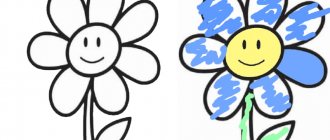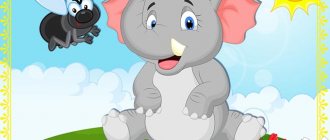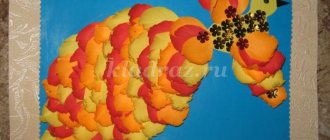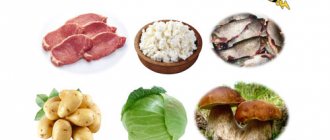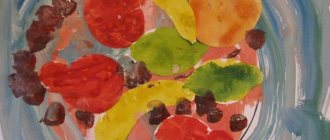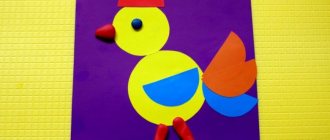Lesson summary for junior group 1 on the topic: “Visiting a chicken family”
MBDOU kindergarten for supervision and health care No. 44, Angarsk, Irkutsk region
Educator
Link to the article, when indicated in the bibliography (according to GOST R 7.0.5–2008):
Savina T.V. Lesson summary for junior group 1 on the topic: “Visiting a chicken family” // Owl. 2016. No. 2. URL: https://kssovushka.ru/e-sovushka.2016.n2-a/VP16030013.html (access date: 02/05/2022).
Program content:
- Expand children's initial understanding of poultry (the composition of a chicken family: a rooster and a hen with chicks), their external differences (a large rooster, a comb and beard on its head; a lush tail made of long feathers, bright plumage; a chicken is also large, but has a tail and comb it is smaller than that of a rooster; the rooster is the father, the hen is the mother; they have children - chickens, they are small, round, fluffy, they run after the chicken, hide under the wing), where they live and what they eat, what benefits they bring to people.
- To develop the ability to recognize and distinguish them on video and in a toy image, recognize the sounds that a rooster, hen, chicks make and imitate them.
- Develop the ability to hear the teacher, imitate words, sound combinations, and movements.
- Enrich children's vocabulary with words: hen, cockerel, chickens, water, grains, feathers, comb, beak, beard, tail, pecks, calls, drinks.
- Continue to introduce children to folklore works that tell about the cockerel, hen, and chickens. Form cognitive activity.
- Foster a caring attitude towards poultry and encourage children to take initiative.
Progress of the lesson: 1. Introductory part. Children enter the group. A chicken can be heard clucking. Educator: Guys, do you hear who is screaming so loudly? (Children's answers) Let's find and see who it is. Children go to the TV and see a picture of a chicken. The teacher invites them to sit on chairs and look at it. 2. Main part. The teacher slowly and expressively acts out a dialogue with the chicken, using a Russian folk saying. - Chicken - Ryabushechka, where did you go? - To the river. - Chicken - Ryabushechka, why did you go? - For some water. - Chicken - Ryabushechka, why do you need some water? - Water the chickens. - Chicken - Ryabushka, how do chickens ask for a drink? - Pi-pi-pi-pi-pi-pi! A hen and squeaking chicks appear on the screen. Educator: Guys, how does a hen call her chickens to her? (children's answers) That's right, the chicken screams: “ko-ko-ko.” — How do chickens ask for water? (children's answers) The teacher invites the children to look at the chicken and chickens. The chicken is the mother, she is big, she has a small comb on her head, a beak and a small beard. There is a small tail of feathers on the body. The chicken's head and entire body are covered with feathers, and there are three long fingers on its legs, with which it rake the ground, looking for grains. And these chickens are her babies. The hen is big, but what kind of chickens are they? (children's response) That's right, the chickens are small, there are many of them, they are round and fluffy. — Guys, what is the name of the chickens’ mother? (children's answers) That's right, chicken. -What does the chicken have on its head? What is the chicken's body and head covered with? (the teacher shows and the children name) A hen and chicks appear on the screen, pecking at grains. Mother hen takes care of her chicks - she protects them, hides them under her wing, teaches them to peck grains and drink water. – Alina, what does the mother hen teach her chickens? (child’s answer) That’s right, the hen and the chickens love to eat grains and drink water, the chickens are still very small, so the mother hen teaches them. Educator: Guys, let's play. I will be a mother chicken, and you will be my chickens. (Puts on a chicken's cap) Physical education The chicken went out for a walk, they follow the teacher, they walk to pinch fresh grass, they squat, they tap their fingers on the floor, and behind her are the chickens - little guys. They follow the teacher - Ko-ko-ko, ko-ko-ko, don’t go far! Row with your paws, look for grains. Ko-ko-ko! They squat and tap their fingers on the floor. The teacher sits the children down and takes off the chicken's cap. - That's how we had a good game of hen and chicks. - Tell Artyom, how does a mother call her children - chickens? (child’s answer) - Varya, how do chickens squeak? (child's answer) - Chickens have not only a mother - a hen, but also a father: a rooster, a cockerel. A rooster, a hen and chicks appear on the screen. The teacher invites the children to look at the cockerel. The rooster is large, like a hen, he has a beak on his head, a large, red comb and a large beard. He is all covered with beautiful feathers. The rooster's tail is beautiful, large, and made of long feathers. He has two legs with spurs. The cockerel screams differently: ku-ka-re-ku! - Tell me how the cockerel crows! (children's answers) (How to compare a chicken and a rooster in their movements?) The teacher reads a nursery rhyme. Cockerel, cockerel, Golden comb, Butter head, Silk beard, Why do you get up early, Sing loudly, Don’t you let the kids sleep? Educator: A chicken family, a cockerel, a hen and chickens are poultry, they live with their grandmother in the village. Grandmother takes care of them, feeds them grain and water. For this, the chicken lays delicious eggs for her. (On the screen, children see how their grandmother feeds a chicken family and lays eggs in a basket). Educator: Guys, the cockerel gave us colorful feathers, let's play with them. Breathing exercises “Blow a feather from your palm” 2 – 3 times. Educator: Guys, did you like playing with feathers? (children’s answers) - Say thank you to the cockerel for his gift, put the feathers in the basket, and we’ll play again later. (Children thank the cockerel and put feathers in the basket). Didactic game “Find out and name it correctly.” - Guys, we also have a chicken family living in our group. (The teacher puts them on the carpet and asks the children to name them) - Renata, who is this? (child's answer) That's right, dad is a cockerel. Elina, did you find out who this is? (child’s answer) That’s right, this mother is a chicken. — Guys, what are the names of the baby hens and roosters? (children's answers) That's right, these are chickens. Didactic game “Feed the chicken family” Let’s feed them (puts two large cups, tells and shows), pour water from buckets into the yellow cup, like this, and pour grain into the green cup with a scoop, from a basket, like that. - Who wants to feed a chicken family themselves? (Children feed themselves; during the game, the teacher asks each child who he is feeding and what with what). Educator: Well done guys, you fed everyone! Let's not disturb them, let them eat. Sit down on the chairs. 3. Final part. Let's play. Didactic game “Find out who is screaming?” - Listen carefully and name who is screaming? (Children listen carefully to the voices of the rooster, hen and chicks and name them) For a chicken family to be healthy, it must be taken care of, fed and watered. — What do hens, cockerels and chicks like to eat? (children's answers) That's right, they love to peck grains and drink water. — What tasty things does chicken give us? (children's answers) That's right, the chicken lays us delicious eggs. (A chicken family appears on the screen, the children say goodbye to it and go to play).
Abstract of the GCD “Poultry and their young”
The rooster came running to the cry,
Down flew out of the duck.
And it was heard in the bushes:
'Ga-ga-ha! Whoa, whoa, whoa!'
This fight is still going on
Remembers the poultry yard.
Educator.
Well, guess where we're going today?
( children's answers)
Educator.
That's right, you and I will take a trip to the poultry yard. And we’ll go to the poultry yard by train - I’ll be a train, and you’ll be a carriage, hurry up - the train is leaving)
(the teacher and the children go in groups to the “Bird Yard” model, located on the table and covered with a tablecloth)
2.A conversation about poultry and their young.
Educator.
The train has arrived at its destination – the “Ptichy Dvor” stop!
(children approach the table, the teacher removes the tablecloth, gives the children a little time to examine the layout, then asks questions)
Educator.
Guys, who lives in this house?
( birds
)
Educator.
What birds do you see in the poultry yard?
( children call
)
Educator.
Do you think anyone is taking care of these birds?
( yes, man
)
Educator.
That's right, it's a man.
The profession of a person who cares for birds is called a poultry keeper if it is a man, and a poultry worker if it is a woman ( the teacher asks you to repeat the names of the profession
).
Educator.
(
circles all the birds with his hand
) These birds live in a special bird house, they are looked after by a person - a poultry house or poultry house, which means these birds cannot exist without a person - what kind of people are they?
( domestic
).
Educator
Are poultry good for humans?
How? ( give meat, eggs
)
Game exercise “Look and Guess”
-
completing the task at the table
(on the table there are pictures depicting wintering and poultry birds)
Educator
Who is this?
( birds)
Educator
Look carefully at the pictures and select only pictures with pictures of poultry.
( having chosen, the child voices his choice
).
Educator
Name the birds that were left lying on the table (
children call wintering birds
)
Educator
why didn't you choose these birds?
( they are wild, people do not care for them)
Educator
true, but don’t forget to help wintering birds - feed them, hang feeders.
Educator
back to the poultry yard (
to the layout
)
Educator
We know that who takes care of poultry?
( children name profession
)
Educator
How does a poultry house or poultry house care for poultry?
( feed, water, clean
)
Educator
what do birds eat from?
( from the feeder
)
Educator
what do they drink from?
( from the drinking bowl
)
Educator
what do poultry eat?
( grain, millet, grass
)
Game exercise “Feed the birds.”
(there is food on the table, children are asked to choose the one they need and pour food into the birds’ feeders)
Educator
Which of the birds in the poultry yard do you think is considered the most beautiful?
(children's answers)
Theme of the week: “Autumn” (pets and birds).
GCD theme: “Poultry yard”.
Directions of development: speech, artistic and aesthetic.
Target:
continue to expand and activate children's vocabulary based on enriching their ideas about their immediate environment.
Tasks:
— continue to introduce poultry and their young;
- give an initial idea of poultry (rooster-hen-chicks, duck-ducklings), their external differences, recognize the sounds that birds make;
- develop the ability to imitate words, sound combinations, movements;
— enrich and activate the vocabulary on the topic;
— cultivate a caring attitude towards poultry;
- develop the ability to roll out lumps of plasticine in a circular motion, use plasticine carefully, and place molded objects on paper (“bird feeder”).
Materials and equipment:
— laptop, speakers; mp3 player;
— presentation “Poultry yard”;
- modeling materials for each child: plasticine, plates, modeling board, napkins;
— painting “Bird Yard”;
- picture “Chicken” on a ribbon (for each child);
- “Chicken” mask, scarf (for the teacher).
Preliminary work
| With kids | With parents | Teacher to GCD |
| Examination of the series of paintings “Pets and Birds” | Questionnaire “Environmental education of children” Preparing details for creating the “Rural Yard” layout | Study and selection of literature Creating a “Rural Yard” layout |
| Reading fiction: Russian folk tale “Ryaba Hen”; songs “Cockerel”, “The sun has friends” | Selection of fairy tales, poems, riddles on the topic | A selection of fairy tales, poems, riddles, illustrations, books on the topic. |
| D/I: “Magic bag”, “Find the extra one!”, “Guess who’s screaming” | Replenishment of the development environment on the topic | Selection of educational games with attributes, pictures, photographs on the topic. |
— Forms of OD organization
| Children's activities | Forms of joint organization activities |
| Motor | Outdoor game “Big - small legs”, “Chicks and hen”, |
| Gaming | Didactic game “Where are the kids” |
| Communicative | Picture Talk (PowerPoint Slides) Word game "Birds and their babies" |
| Fine | Modeling |
| Cognitive and research | Surprise moment "What's hidden" |
Logic of educational activities
| № | Activities of the teacher | Pupils' activities | Expected Result |
| Motivation. Introductory part. | |||
| 1 | Audio recording: a cockerel is crowing.” An image of a cockerel appears on the screen | They pay attention, consider, answer the question “Who is this?” | Motivation for subsequent educational activities has been created |
| Main part | |||
| 2 | Conversation based on slides: presentation “Bird Yard” with the active game “Big - Little Legs” | Look at the photo slides. They answer the questions “Who is this?”, “How does it scream?”, “What are the cubs called?” Perform movements together with the teacher | Elementary ideas about poultry and their chicks have been formed |
| Puts forward the problematic situation “What to feed the chickens?” | Children make their own guesses | The ability to find a solution is formed | |
| Brings in a container with millet grains, massage balls are hidden inside | Examine and touch the grain with their hands | Prepare for productive activities | |
| Surprise "What's inside?" moment. Invites children to find a surprise | Children find massage balls in millet | Motivation for upcoming activities | |
| Explains, shows how to sculpt grains from plasticine, and where to put them | Perform movements with the teacher using balls (a method of rolling a lump in a circular motion) | Development of tactile sensations, the ability to roll out plasticine in a circular motion | |
| Invites children to make grains for chickens in the same way. | Children make their own grains | Cultivating a desire to help. Strengthening the ability to roll out plasticine | |
| Shows chickens (a picture for each child) that they want and offers to feed | Children look at the chickens, bring their plates and “feed” them. | Forming a feeling of caring | |
| Outdoor game "Chicks and hen" The teacher puts on a “hen” mask and a scarf, turns into a “mother hen”, and invites the children to be her chickens. | Children put on pictures of chickens and join the game. | Formation of the ability to jointly perform movements. Promote a positive emotional mood. | |
| Final part. Summarizing | |||
| Game activity “Where are the kids”, invites children to hide, searches and finds baby birds, invites them to voice them and name their mother | Act in accordance with the game plot set by the teacher | Generalization and consolidation of acquired knowledge | |
Working with children in sensitive situations:
outdoor games “Mother Hen and Chicks”, didactic game “Who Screams”, “Find Mom”, looking at the album “Poultry”, modeling.
